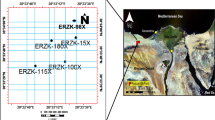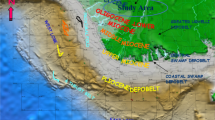Abstract
The reservoir properties of three wells in Royal Field, Niger Delta basin was characterized using fundamental formula. The distributions and thicknesses of sand bodies were determined within each of the wells in the field using geophysical modeling software. The quantitative and qualitative analyses were done for the three exploration wells with the depth ranges of 4000-9700m for Royal well 1, 1000-8805m for Royal well 2, and 4000-8000m for Royal well 3. Each well has identified sand units. Royal well 1 and Royal well 2 have 5 sand units (A, B, C, D, E) each, with respective thicknesses 422m, 110m, 92m, 142m and 350m for well 1, and 82m, 65m, 214m, 362m, and 192m for well 2. Royal well 3 has 4 sand units (A, B, C, D), with respective thicknesses 135m, 80m, 269m and 229m. Petrophysical evaluations were made from well logs. The average porosity values obtained for Royal wells 1, 2, and 3 are 0.24, 0.18 and 0.22 respectively while the corresponding average permeability values are 2789mD, 1292mD, 1643mD. Porosity values obtained from porosity logs and density log (RHOB) using porosity formula are found to be within the range of 0.07- 0.45, while their permeabilities range from 164 to 8453 milli Darcy. The water saturation obtained for each reservoir unit in combination with the resistivity index were used to prove the presence of hydrocarbon in these sands. Royal well 2 having its sand A, 80% hydrocarbon saturated and 82m thickness is the most prolific. The results clearly indicate that the application of this technique is very effective for the interpretation of reservoir properties.
Similar content being viewed by others
References
ADAEZE, I.U., SAMUEL, O.O. and CHUKWUMA, J.I. (2012) Petrophysical evaluation of uzek well using well log and core data, Offshore Depobelt, Niger Delta, Nigeria. Adv. Appld. Sci. Res., v.3(5), pp.2966–2991
ADEJOBI, A.R. and OLAYINKA, A.I. (1997) Stratigraphy and hydrocarbon potential of the Opuama channel complex area, western Niger delta. Nigerian Assoc. of Petrol. Expl. (NAPE) Bull., v.12, pp.1–10.
AIGBEDION, I. and IYAYI, S.E. (2007) Formation evaluation of Oshioka field using geophysical well logs. Middle-east Jour. Sci. Res., v.2(3-4), pp.107–110.
AMIGUN, J.O., OLISA, B. and FADEYI, O.O. (2012) Petrophysical analysis of well logs for reservoir evaluation: A case study of ‘Laja’ Oil Field, Niger Delta. Jour. Petrol. Gas Explo. Res., v.2(10), pp.181–187.
ARCHIE, G.E. (1942) The Electrical Resistivity as an Aid in Determining Some Reservoir Characteristics. Jour. Petrol. Technol., v.5, pp.54–62
ASQUITH, G. and GIBSON, C. (1982) Basic well log analysis for geologists Amer. Assoc. of Petrol Geol. Tulsa, Methods in Exploration Ser. no.216.
ASQUITH, G. and KRYGOWSKI, D. (2004) Basic Well Log Analysis, second edition, AAPG Methods in Exploration Series, no.16, pp.52–62.
BENJAMIN, U.K. and NWACHUKWU, J.I. (2011) Model compaction equation for hydrostatic sandstones of the Niger delta. Ife Jour. Sci., v.13(1), pp.161–174.
BILOTTI, F. and SHAW, J.H. (2005) Deep water Niger Delta Fold and Thrust Belt modeled as a Critical–Taper Wedge: The Influence of Elevated Basal Fluid Pressure on Structural Styles. AAPG Bull., v.89(11), pp.1475–1491.
DOUST, H. and OMATSOLA, E. (1989) Niger Delta. In: Edwards, J.D. and Santogrossi, P.A. (Eds.), Divergent/passive margin basins. AAPG Mem., v.48, pp.201–238.
DRESSER ATLAS, (1979) Log interpretation fundamentals. Dresser Industries Inc.
EGBAI, J.C. and AIGBOGUN, C.O. (2012) Mathematical modelling of petrophysical parameters for reservoir characterization using well log data. Adv. Appld. Sci. Res., v.3(2), pp.656–670.
EKWEOZOR, C.M. and DAUKORU, E.M. (1994) Northern delta depobelt portion of the Akata-Agbada petroleum system, Niger Delta, Nigeria. In: Magoon, L.B., and Dow, W.G. (eds) The Petroleum System—from Source to Trap, AAPG Mem., no.60, Tulsa, America.
HALLIBURTON, (2001) Basic Petroleum geology and log interpretation, pp.28–30
KULKE, H. (1995) Regional petroleum geology of the world, part II: Africa, America, Australia and Antarctica. Berlin, Gebruder Borntraeger. pp.143–172
MORRIS, R.L. and BRIGGS, W.P. (1967) Using log-derived values of water saturation and porosity: Soc. Professional Well Log Analysts, 8th Ann. Logging Symp. Trans., paper
NNPC (2005) Overview of the Nigerian Petroleum Industry and Opportunity for Investment. Paper Presented at the 18th World petroleum Congress. Johannesburg, South Africa, Sept.25-29
OBAJE, N.G. (2009) Geology and Mineral Resources of Nigeria, Lecture Notes in Earth Sciences 120. Springer-Verlag
OWOYEMI, A.O. and WILLIS A.O. (2006) Depositional Patterns Across Syndepositional Normal Faults, Niger Delta, Nigeria. Jour. Sedimentary Res., v.76, pp.346–363.
SCHLUMBERGER, (1972) Log interpretation/chart. Houston, SchlumbergerWell Services, Inc.
SHORT, K.C. and STAUBLE A.J. (1967) Outline of Geology of Niger delta. AAPG Bull., no.51, pp.761–779
TIXIER, M.P. (1949) Evaluation of Permeability from Electric Log Resistivity Gradients. Oil and Gas Jour., v.8, pp.75–90.
WHITEMAN, A.J. (1976) Nigeria: its petroleum, geology, resources and potential. Vol. I and II. Edinburgh, Graham and Trotman.
Author information
Authors and Affiliations
Corresponding author
Rights and permissions
About this article
Cite this article
Obiora, D.N., Gbenga, D. & Ogobiri, G. Reservoir characterization and formation evaluation of a “Royal onshore field”, Southern Niger Delta using geophysical well log data. J Geol Soc India 87, 591–600 (2016). https://doi.org/10.1007/s12594-016-0433-6
Received:
Revised:
Published:
Issue Date:
DOI: https://doi.org/10.1007/s12594-016-0433-6




